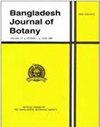Cell membrane injury, stability and atpase actibity and their relevance to seed germination, seedling growth tolerance indices of rice under abiotic stresses
IF 0.3
4区 生物学
Q4 PLANT SCIENCES
引用次数: 0
Abstract
Abiotic stress tolerant germplasms of field crops are useful for cultivation under growth limiting conditions. In the present study 18 different rice germplasms for their cell membrane injury (CMI), cell membrane stability (CMS), ATPase activity and their relevance to seed germination and seedling growth tolerance index (TI) under abiotic stresses like salinity and low Ψw were investigated. At least 12 germplasms had relatively low membrane injury (< 10%) and consequently high membrane stability (> 90) including TM-1-5, Sadachikon, SR x P 5222, BR 23, Pokkali, Nonabokra, etc. indicating a relationship between stress tolerance and CMS. ATPase activities in some of these rice germplasms were high along with CMS related to stress tolerance. The TI of seed germinations and seedling growth of different germplasms under salinity stress were affected in different degrees and decreased more under high intensities. At 0.l Molal NaCl all germplasms had ≤ 80% TI of seed germination, at 0.2 Molal NaCl only three had ≥ 80% TI and ten had ≥ 50% TI and at 0.3 Molal NaC1, only nine had ~10-32% TI and the rest nine did not germinate. Osmoticum PEG-6000 at -5.5 bar Ψw had limited inhibitory effect on seed germination TI. NaCl as well as PEG-6000 degraded both the root and shoot growth TI of the seedlings. Bangladesh J. Bot. 52(3): 889-896, 2023 (September)非生物胁迫下水稻的细胞膜损伤、稳定性和磷酸酶活性及其与种子萌发、幼苗生长耐受性指数的关系
耐受非生物胁迫的大田作物种质可用于生长受限条件下的栽培。本研究调查了 18 种不同水稻种质的细胞膜损伤(CMI)、细胞膜稳定性(CMS)、ATPase 活性及其与种子萌发和幼苗生长耐受指数(TI)在盐度和低Ψw 等非生物胁迫条件下的相关性。至少有 12 个种质具有相对较低的膜损伤(< 10%)和较高的膜稳定性(> 90),包括 TM-1-5、Sadachikon、SR x P 5222、BR 23、Pokkali、Nonabokra 等,这表明胁迫耐受性与 CMS 之间存在关系。其中一些水稻品种的 ATP 酶活性较高,这与抗逆性和 CMS 有关。在盐分胁迫下,不同种质的种子发芽率和幼苗生长受到不同程度的影响,在高胁迫下,种子发芽率和幼苗生长受到的影响更大。在 0.l Molal NaCl 条件下,所有种质的种子萌发 TI 均不超过 80%;在 0.2 Molal NaCl 条件下,只有 3 个种质的种子萌发 TI ≥ 80%,10 个种质的种子萌发 TI ≥ 50%;在 0.3 Molal NaC1 条件下,只有 9 个种质的种子萌发 TI 约为 10-32%,其余 9 个种质没有萌发。在 -5.5 bar Ψw 条件下,渗透压 PEG-6000 对种子萌发 TI 的抑制作用有限。NaCl 和 PEG-6000 会降低幼苗根部和芽部的生长 TI。孟加拉国植物学报52(3):889-896, 2023 (September)
本文章由计算机程序翻译,如有差异,请以英文原文为准。
求助全文
约1分钟内获得全文
求助全文
来源期刊

Bangladesh Journal of Botany
生物-植物科学
CiteScore
0.80
自引率
0.00%
发文量
77
审稿时长
9 months
期刊介绍:
Bangladesh in situated on the north of Bay of Bengal. Climatically it is a humid subtropical country. Most of the land is deltaic plain of two great rivers, the Ganges and the Bhrammaputra and it tributaries. The country has rich diversity of plants. Main crops cultivated are Rice, Jute, Wheat, Maize, Sugarcane, Mustard and different kinds of Lentils. There are a good number of Public and Private Universities and Plant Research Establishments.
Bangladesh Journal of Botany is the official organ of the Bangladesh Botanical Society established in 1972. Since 1972 Bangladesh Journal of Botany is being published regularly. Two issues of the Journal are published, one in June and another in December.
Scientific papers (Full paper and short communication) on any field of Plant Sciences from anywhere in the World are considered for publication in Bangladesh Journal of Botany.
 求助内容:
求助内容: 应助结果提醒方式:
应助结果提醒方式:


